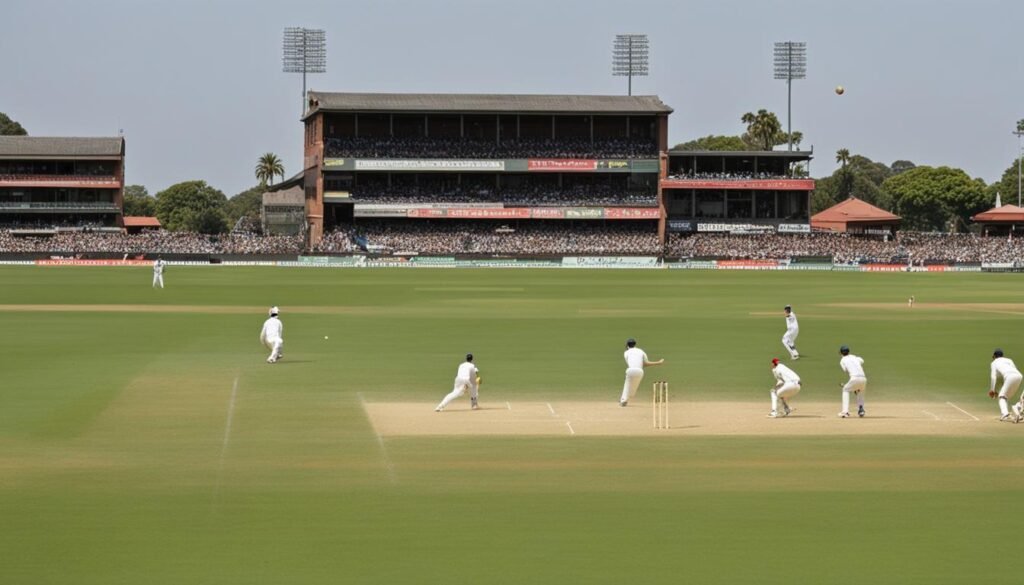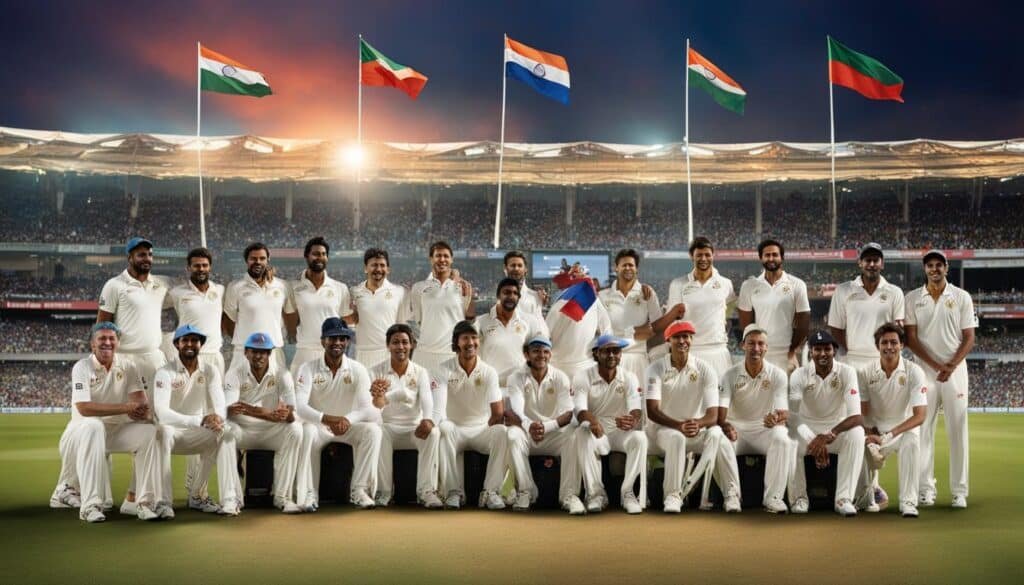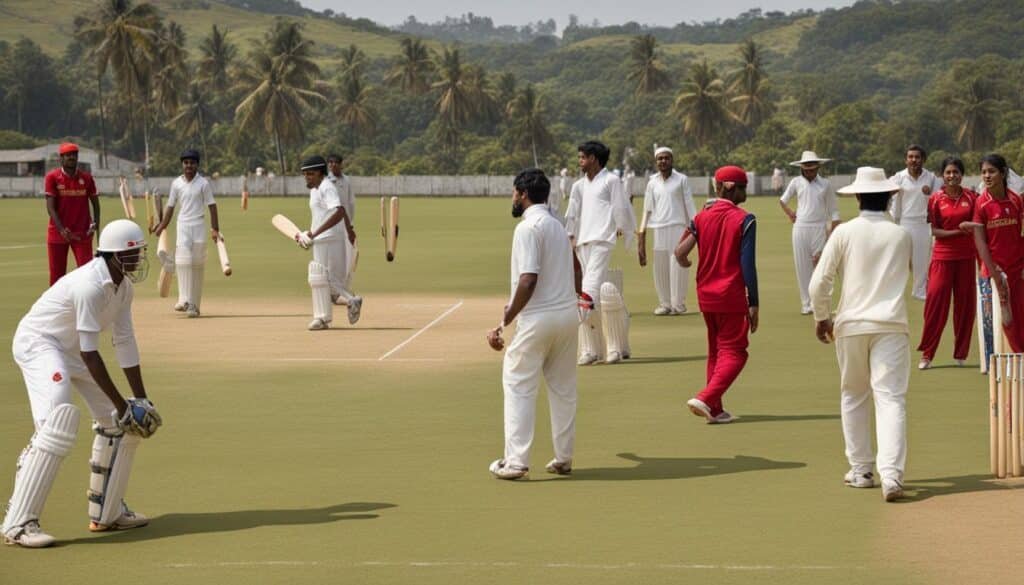Cricket’s Global Appeal : Cricket, with its rich history and universal appeal, has become a global phenomenon. Originating in England in the 16th century, the sport has transcended boundaries and captivated fans across continents. Cricket’s strategic battles, cultural impact, and the emergence of global icons have contributed to its immense popularity and global following.
- Cricket’s international presence and popularity have grown exponentially over time.
- The sport offers strategic battles and thrilling competition that engage fans worldwide.
- Cricket has a significant cultural impact and fosters national pride in many nations.
- Legendary players have become global icons, inspiring generations of cricket fans.
- The sport continues to evolve and innovate, keeping it relevant in the modern era.
The Rich History and Heritage of Cricket
Cricket, a sport with a rich history that dates back to the 16th century in England, has evolved into a beloved game worldwide. Its legacy spans across nations like India, Australia, South Africa, and the West Indies, captivating millions of fans with its thrilling encounters and sporting prowess. The evolution of cricket and its diverse formats have played a pivotal role in its enduring popularity and global appeal.
The Evolution of Cricket
Cricket has witnessed significant evolution throughout its long history. From its humble beginnings as a rural pastime in England, it has now become an internationally recognized sport with multiple formats that cater to different playing styles and preferences.
The most traditional and time-honored form of cricket is Test matches. Played over five days, Test matches are a test of endurance, skill, and strategy. It is cricket in its purest and most traditional form, where players display their technical abilities and mental fortitude. Test cricket’s rich history and the iconic battles it has produced have made it the epitome of the sport.
Also Read: Discovering The Hidden Gems Of Cricket’s Past
As the pace of life increased and attention spans shortened, the demand for shorter and more dynamic versions of cricket emerged. One such format is One Day Internationals (ODIs), where teams battle it out in a single day, facing a limited number of overs. ODIs introduced a sense of urgency and excitement to the game, captivating a larger audience and paving the way for further innovations.
However, it was the introduction of Twenty20 (T20) cricket that truly revolutionized the sport. T20 cricket condensed the game into a fast-paced format that could be completed in just a few hours. With its emphasis on explosive batting, innovative shots, and aggressive fielding, T20 cricket injected a new level of entertainment and thrill into the sport. It has gained immense popularity, attracting a broader fan base and generating significant commercial interest.
The Global Influence of Cricket
The evolution of cricket, from Test matches to ODIs and T20 cricket, has played a pivotal role in shaping the sport’s global appeal. It has allowed cricket to adapt to the changing preferences of fans and create diverse viewing experiences.
Also Read: Top Cricket Bats To Elevate Your Game
The evolution of cricket formats has been instrumental in expanding the sport’s reach and engaging fans across the world. It has enabled cricket to cater to different audiences, from traditional enthusiasts who appreciate the strategic battles of Test matches to the excitement-seeking fans who are drawn to the fast-paced action of T20 cricket.
Moreover, the evolution of cricket formats has also opened doors for wider participation and talent development. The shorter formats have allowed players to showcase their skills in a more accessible and spectator-friendly manner, attracting aspiring cricketers from diverse backgrounds and nations.
Countries like India, Australia, South Africa, and the West Indies have embraced cricket as an integral part of their sporting culture. The sport has allowed these nations to showcase their cricketing talents, foster national pride, and create enduring cricketing legacies.
Through its rich history and evolution into different formats, cricket has become a sport that resonates with fans worldwide. Its ability to adapt and innovate has contributed to its enduring popularity, making it a true global phenomenon.
Also Read: A Beginner’s Guide To Cricket Strategy
The Thrill of Competition in Cricket

Cricket offers a thrilling experience for fans with its intense competition and display of skill. The battle between batsmen, bowlers, and fielders creates moments of excitement and anticipation. Breathtaking sixes, precise yorkers, and acrobatic catches are just some of the highlights that make cricket a theater of athleticism and strategy.
Also Read: Exploring Cricket’s Cultural Impact Worldwide
Incredible Moments of Skill and Strategy
Cricket is a sport that demands exceptional skills from its players. The intense competition on the field pushes cricketers to showcase their athleticism and strategic thinking. From the powerful hits of a batsman sending the ball soaring over the boundary to the precise delivery of a fast-paced yorker by a bowler, these moments of brilliance are what make cricket a captivating spectacle.
The athleticism displayed by cricketers is truly mesmerizing. Fielders diving full-length to grab a flying ball, wicketkeepers swiftly catching lightning-fast deliveries, and bowlers stretching their bodies to bowl toe-crushing yorkers are all testaments to the remarkable physical abilities required in cricket.
“Cricket is a challenging sport that pushes players to the limit of their physical and mental capabilities. The intense competition brings out their best skills and athleticism, creating unforgettable moments for fans.” – Former cricketer, Michael Clarke
A Battle of Strategies
Cricket is not just a game of brute force and athleticism; it is also a game of strategy and tactics. Captains make critical decisions, such as setting field placements, selecting bowlers, and devising plans to outsmart the opposition. Batsmen carefully analyze the field and bowlers, anticipating their next move. Bowlers use clever variations and deceptive deliveries to confuse the batsmen. The interplay of these strategic decisions adds an additional layer of excitement to the competition.\
Also Read: How Does Network Process Technology Work?
Every match is filled with moments of intense competition where cricketers showcase their skills and athleticism to gain an edge over their opponents. Whether it’s a close-run chase, a fiercely contested Test match, or a high-scoring T20 encounter, cricket never fails to deliver nail-biting moments and keep fans on the edge of their seats.
The relentless pursuit of victory
In cricket, the pursuit of victory drives players to push their limits and overcome challenges. The intense competition fuels their determination to outperform their rivals and secure glory for their team. It is this quest for success that leads to exceptional feats on the field and inspires admiration from fans around the world.
| Cricket Skills | Examples | Athleticism | Examples |
|---|---|---|---|
| Batting | Scoring centuries, hitting sixes | Diving catches | One-handed catches, catching near the boundary |
| Bowling | Taking wickets, bowling yorkers | Fielding | Direct hit run-outs, boundary saves |
Cricket’s Cultural Impact

Cricket transcends being merely a sport in many nations; rather, it is woven into the very fabric of their culture. The cultural impact of cricket can be witnessed in major tournaments like the ICC Cricket World Cup, which stirs up intense national pride and fosters unity among diverse communities. Cricket has a remarkable ability to bridge divides and ignite celebrations, creating a sense of camaraderie among passionate fans.
The Power of Cricket Tournaments
Cricket tournaments, such as the ICC Cricket World Cup, hold immense significance for participating nations. These events showcase the best cricketing talent from around the world and bring people together, irrespective of their differences. Fans are united by a shared love for the game and a deep-rooted pride in their national teams. The excitement and anticipation surrounding these tournaments create an electric atmosphere that reverberates throughout the host country.
“Cricket tournaments have the power to elevate national pride and transcend cultural barriers, fostering a sense of unity among nations.” – Cricket enthusiast
Cricket tournaments not only ignite fervor among fans but also contribute to the cultural heritage of a nation. The moments of triumph and the emotional rollercoaster of victories and defeats become part of a country’s collective memory, shaping its cultural narrative and instilling a profound sense of national identity.
The Cultural Significance in Action: The ICC Cricket World Cup
The ICC Cricket World Cup is a prime example of how cricket tournaments breed cultural significance. Held every four years, this prestigious tournament brings together teams from all cricket-playing nations, captivating millions of fans worldwide. The World Cup showcases the pinnacle of cricketing excellence and offers a platform for countries to exhibit their cricketing prowess.
It is during this tournament that the passion and national pride overflow, transcending geographical boundaries. Fans unite in a collective celebration of their country’s cricketing achievements, creating an atmosphere of joy and camaraderie. The tournament sparks conversations, traditions, and rituals unique to each participating nation, further strengthening the cultural bond between cricket and national identity.
| Cricket Tournaments | Cultural Impact |
|---|---|
| ICC Cricket World Cup | Fosters national pride and unity among diverse communities |
| Indian Premier League (IPL) | Brings together cricketing talent from around the world, showcasing cultural diversity |
| Ashes Series | Symbolizes historic cricket rivalry between England and Australia, adding richness to their cultural narratives |
The cultural impact of cricket tournaments extends beyond the sport itself, leaving a lasting legacy in the hearts and minds of fans. These events become an integral part of a nation’s cultural tapestry, fueled by the collective pride and cherished memories they create.
Global Icons and Heroes of Cricket

Cricket has produced legendary figures who have earned adoration worldwide. Players like Sir Don Bradman, Sachin Tendulkar, and Brian Lara have etched their names in cricketing folklore, inspiring generations of fans.
“He [Bradman] was the best batsman I ever saw.”
– Steve Waugh
The exceptional skills and accomplishments of these cricketing icons on the field have catapulted them to global stardom. Their mesmerizing batting prowess, remarkable records, and iconic moments have solidified their positions as true heroes of the sport.
Don Bradman: The Invincible
Sir Don Bradman, hailed as the greatest batsman of all time, possesses a batting average of 99.94 in Test cricket – a record that remains unmatched to this day. His extraordinary consistency, technique, and mental fortitude have elevated him to legendary status in the world of cricket.
Sachin Tendulkar: The Master Blaster
Sachin Tendulkar, known as the “Little Master,” has captivated cricket fans globally with his elegant stroke play and exceptional run-scoring ability. Throughout his illustrious career, Tendulkar amassed numerous records, including being the highest run-scorer in both Test and One-Day International (ODI) cricket.
Brian Lara: The Prince of Trinidad
Brian Lara’s breathtaking stroke play and immense talent have left an indelible mark in cricketing history. The left-handed Trinidadian holds the record for the highest individual score in Test cricket – a monumental 400 runs. Lara’s artistry with the bat continues to inspire cricketers around the world.
“If I had to bowl to Sachin Tendulkar, I would bowl with my helmet on. He hits the ball so hard.”
– Wasim Akram
These legendary cricketers have not only achieved remarkable individual success but have also played a pivotal role in shaping the narrative of the sport. Their contributions to the game have become an integral part of cricketing folklore, forever etched in the hearts of fans worldwide.
Innovation and Evolution in Cricket

Cricket, like any other sport, has undergone significant innovation and evolution over the years. These advancements, driven by technology and a desire to enhance the game, have revolutionized the way cricket is played and experienced by fans.
One of the notable innovations in cricket is the introduction of the Decision Review System (DRS). This technology allows teams to challenge umpire decisions by requesting a review based on video evidence. The DRS has added a layer of accuracy and fairness to the game, reducing the possibility of human error and ensuring more consistent outcomes. It has become an integral part of international cricket, sparking discussions and influencing the course of matches.
Another major innovation in cricket is the advent of T20 leagues, with the Indian Premier League (IPL) being at the forefront. T20 cricket, a shorter and more fast-paced version of the game, has captivated audiences with its high-scoring matches and thrilling finishes. The IPL, with its glitz, glamour, and star-studded line-ups, has revolutionized the cricketing landscape, attracting global talent and creating new avenues for players and fans alike.
“The introduction of the Decision Review System and the rise of T20 leagues like the IPL have transformed cricket into a more exciting and technologically advanced spectacle.” – Expert cricket analyst
In addition to these innovations, there have been significant advancements in bat and ball technology. Modern cricket bats are designed to provide maximum power and precision to batsmen, enabling them to hit bigger sixes and play innovative shots. On the other hand, ball manufacturers have worked towards producing cricket balls that swing, seam, and spin more effectively, challenging the skills of the batsmen.
Advancements in Bat Technology
Here is a list of some significant technological advancements in bat design:
- Thicker edges and larger sweet spots for improved power
- Composite materials for better shock absorption and enhanced bat performance
- Weight distribution techniques for improved balance and maneuverability
Advancements in Ball Technology
Here is a list of some significant technological advancements in ball design:
- Advanced manufacturing techniques for better seam and swing movement
- Improved leather quality for increased grip and spin
- Construction modifications to achieve ideal hardness and durability
The combination of these innovations and technological advancements has made cricket more dynamic, engaging, and relevant in the modern era. Fans are treated to a visually captivating spectacle, filled with explosive batting, skillful bowling, and agile fielding.
The constant evolution of cricket ensures that the sport remains exciting and enthralling for players and fans alike. As technology continues to advance, we can expect further innovations that push the boundaries of the game and unveil new possibilities.
Cricket’s Impact on Society

Cricket is not just a sport played on the field; it holds the power to create positive change and build stronger communities. Through a wide range of initiatives, cricket serves as a platform for social transformation and community development. This section explores how cricket extends its influence beyond the stadiums and contributes to the betterment of society.
Social Change through Cricket
Cricket has the ability to address important social issues and advocate for change. Organizations and individuals utilize the sport’s popularity to raise awareness about various causes such as education, healthcare, gender equality, and poverty alleviation. By leveraging the global appeal of cricket, these initiatives have the potential to make a significant impact and bring about positive transformations in communities around the world.
“Cricket is a powerful tool that transcends cultural, religious, and social barriers. It has the potential to foster unity, open dialogue, and promote inclusivity.”
Community Development Programs
Cricket plays a crucial role in community development by promoting teamwork, leadership skills, and values such as discipline and fair play. Community-based cricket programs provide opportunities for individuals, especially youth, to engage in organized sports and develop life skills. These programs not only enhance physical fitness but also instill important values that contribute to personal growth and social cohesion.
Charity Initiatives
Cricket has been a driving force behind numerous charity initiatives around the world. Players, teams, and cricketing bodies actively participate in fundraising events and campaigns to support various causes, including disaster relief, healthcare, and education. The sport offers a platform for athletes to use their influence and resources for the betterment of society, making a tangible difference in the lives of those in need.
Case Study: The Cricket Without Boundaries Foundation
An exemplary organization making a significant impact is the Cricket Without Boundaries Foundation. Founded in 2005, this UK-based charity uses cricket as a vehicle for social change in countries affected by HIV/AIDS. Through coaching programs and health education, Cricket Without Boundaries aims to tackle stigma, promote awareness, and empower individuals and communities. Their work showcases the transformative power of cricket in addressing global challenges and spreading positive change.
Cricket Diplomacy: Building Bridges through Sport

Cricket has proven to be more than just a game; it has become a powerful tool for diplomacy, fostering international relationships and bridging divides. The sport’s ability to transcend borders and unite nations has led to numerous instances where cricket played a significant role in improving international relations.
One notable example is the cricket rivalry between India and Pakistan. Despite political tensions between the two nations, their shared love for cricket has brought moments of camaraderie and sportsmanship. The matches between India and Pakistan not only captivate cricket fans but also have the potential to initiate dialogue and ease tensions.
Another remarkable instance of cricket diplomacy was demonstrated by Fidel Castro, the former Cuban leader. He recognized the symbolic value of cricket and its association with British colonial influence. By embracing the sport, Castro aimed to challenge American dominance and assert Cuban independence.
Furthermore, China’s diplomatic gesture of building a cricket stadium in Grenada is a testament to the significance of cricket in international relations. This act fostered closer ties between China and Grenada, showcasing the power of sports as a means to strengthen diplomatic bonds.
The Role of Cricket Diplomacy
Cricket diplomacy serves as a platform for open dialogue and exchange between nations, allowing them to set aside political differences and focus on shared sporting endeavors. It provides an opportunity for communication, understanding, and the building of cultural connections.
Cricket tournaments have the potential to create a sense of unity and mutual respect among nations, transcending political boundaries.
The Impact of Cricket Diplomacy
The impact of cricket diplomacy goes beyond the field, extending to diplomatic relations, cultural understanding, and public diplomacy. Through initiatives such as sports exchange programs, intercultural events, and friendly matches, cricket plays a pivotal role in promoting peace, harmony, and mutual respect among nations.
Cricket diplomacy not only strengthens bilateral ties but also contributes to people-to-people connections, fostering a sense of global community.
| Benefits of Cricket Diplomacy | Examples |
|---|---|
| Promotes cultural exchange | India vs. Pakistan cricket matches |
| Enhances diplomatic relations | China’s cricket stadium in Grenada |
| Facilitates people-to-people connections | Fidel Castro using cricket as a diplomatic tool |
When leaders and nations come together to embrace the spirit of cricket, it serves as a catalyst for positive change, breaking down barriers and fostering understanding. This unique form of diplomacy demonstrates the power of sports in transcending political differences and building bridges between nations.
How Cricket Shaped National Identities

Cricket, as a sport, has played a vital role in shaping the national identities of various countries across the globe. Let’s explore how this beloved game has become an integral part of the cultural heritage in different nations.
India: Passion and Adoration
In India, cricket is more than just a sport; it is a matter of national pride and an intrinsic part of the country’s cultural fabric. The passion for cricket runs deep in the veins of every Indian, transcending regions, languages, and socio-economic backgrounds. From gully cricket matches to filling iconic stadiums like the Eden Gardens or Wankhede, cricket is a unifying force that brings the nation together.
“Cricket is not just a game in India, it’s a religion.”
Australia: The Spirit of Competitiveness
In Australia, cricket is synonymous with the nation’s love for fierce competition and the pursuit of excellence. The “Baggy Green” cap holds immense significance, representing the spirit of the game and the honor bestowed upon players who don it. The intense rivalry with England in the Ashes series further fuels the competitive nature of Australian cricket and stirs national pride.
The West Indies: A Legacy of Excellence
In the West Indies, cricket has left an indelible mark, not only as a sport but as a symbol of national identity. The region has produced some of the most exceptional cricketers the world has ever seen, showcasing an unmatched legacy of excellence. From the formidable pace of the fearsome West Indian fast bowlers to the stylish stroke play of their batsmen, West Indies cricket represents the vibrancy, resilience, and rich cultural tapestry of the Caribbean nations.
These are just a few examples of how cricket has shaped the national identities of various countries. From England, where the sport originated, to countries like Pakistan, South Africa, and Sri Lanka, each nation has its unique relationship with cricket that reflects its values, traditions, and history.
| Country | Key Aspect of National Identity |
|---|---|
| India | Passion and adoration for cricket as a unifying force |
| Australia | The spirit of competitiveness and pursuit of excellence |
| The West Indies | A legacy of excellence, representing vibrancy and resilience |
| Pakistan | Cricket as a means of national pride and unity |
| South Africa | The reflection of social change and post-apartheid reconciliation |
| Sri Lanka | The representation of perseverance and overcoming adversity |
Cricket in India: A Cultural Phenomenon
In India, cricket is more than just a sport; it is a way of life. The game unites people from all walks of life and serves as a reflection of the country’s passion, resilience, and cultural identity. The Indian Premier League (IPL) has further elevated the status of cricket in India, making it a global powerhouse in the sport.
The IPL, established in 2008, has transformed the cricketing landscape in India. This annual Twenty20 tournament brings together top international players and showcases their incredible talent. The IPL has not only revolutionized cricket with its fast-paced format but has also become a major source of entertainment and pride for millions of cricket fans in India and around the world.
The IPL has not only revolutionized cricket with its fast-paced format but has also become a major source of entertainment and pride for millions of cricket fans in India and around the world.
The IPL not only provides young talent in India with a platform to showcase their skills but also offers numerous business opportunities. The tournament attracts massive investments from corporate sponsors, leading to financial growth and employment opportunities for many.
Cricket runs deep in the veins of Indian society, with the sport ingrained in the collective consciousness of the nation. The Indian cricket team’s success on the international stage is a matter of great national pride, and the achievements of players like Sachin Tendulkar, Kapil Dev, and Virat Kohli have elevated them to the status of national heroes.
Cricket: A Catalyst for Social Change
Cricket in India goes beyond the boundaries of stadiums. It has the power to bring about social change and uplift communities. Several initiatives and programs leverage the popularity of cricket to address issues like education, healthcare, and gender equality.
“Cricket is not just a sport, it is an emotion in India. It has the ability to transcend societal barriers and unite people in a way that few things can.”
The passion for cricket in India can be witnessed during major tournaments like the ICC Cricket World Cup, where streets come alive with celebrations, and people from all backgrounds come together to cheer for their team. Cricket is not just a sport, it is an emotion in India. It has the ability to transcend societal barriers and unite people in a way that few things can.
Through cricket, India has established itself as a dominant force in the international cricketing arena. The relentless pursuit of excellence, coupled with the unwavering support of millions of fans, has made cricket an integral part of India’s cultural fabric and a symbol of national pride.
Cricket’s Economic Impact

When examining the intersection of cricket and the economy, one cannot overlook the immense financial influence of the Indian Premier League (IPL). As one of the most lucrative cricket leagues in the world, the IPL generates substantial revenue through various channels, including ticket sales, merchandise, broadcasting rights, and sponsorships.
The IPL’s financial impact extends beyond the league itself. It has acted as a catalyst for the growth of ancillary industries and attracted significant investment in cricket-related sectors. The league’s success has created opportunities for businesses involved in sports marketing, advertising, hospitality, and event management.
The economic influence of the IPL can be observed through the substantial revenue it generates. Each year, cricket enthusiasts flock to stadiums across India, filling seats and purchasing tickets, contributing to the league’s financial success. Furthermore, the sale of IPL merchandise, including team jerseys, souvenirs, and accessories, provides an additional revenue stream.
The IPL has revolutionized the dynamics of cricket and established new benchmarks in terms of revenue generation through sponsorships and broadcasting rights deals. The financial impact of the league cannot be overstated.
Sponsorships play a vital role in the financial ecosystem of the IPL. Companies from various industries vie for the opportunity to align their brand with a team or player, leveraging the immense popularity and reach of the league to promote their products and services. These sponsorships provide a significant source of revenue for both the IPL and the associated teams.
Additionally, broadcasting rights contribute substantially to the economic success of the IPL. Television networks and digital platforms compete for the rights to broadcast matches, showcasing the league to a global audience and attracting substantial advertising revenues. The broadcasting deals provide a significant portion of the league’s overall revenue.
Overall, the economic impact of cricket, particularly through the Indian Premier League, is undeniable. The league’s ability to generate revenue, stimulate ancillary industries, and attract investments showcases the symbiotic relationship between cricket and the economy.
Cricket Economy by the Numbers
| Year | Revenue Generated (in millions) | % Increase from Previous Year |
|---|---|---|
| 2010 | USD 663 | – |
| 2015 | USD 3,000 | 352% |
| 2020 | USD 5,951 | 98% |
It is evident from the table above that the economic impact of cricket, particularly through the IPL, has witnessed significant growth over the years. The revenue generated by the league has experienced exponential growth, attracting attention from investors and further solidifying cricket’s position as a major player in the global sports economy.
Conclusion
Cricket’s enduring legacy is a testament to its global appeal. With its rich history, intense competition, and cultural impact, the sport has captured the hearts of fans around the world. Through the years, cricket has transcended borders and united nations, fostering a sense of pride and identity.
The emergence of iconic players like Sir Don Bradman, Sachin Tendulkar, and Brian Lara has further cemented cricket’s place in sporting folklore. Their extraordinary skills and accomplishments have inspired and captivated generations of fans, contributing to the sport’s global popularity.
As cricket continues to evolve and embrace innovation, it remains a dynamic and engaging sport. From the exciting T20 format to the advancements in technology, cricket constantly adapts to captivate its audience. The sport’s ability to bring about positive social change and its role in international diplomacy further reinforce its significance in the world.
Cricket’s enduring legacy and global appeal will ensure that it remains a beloved sport for years to come. It will continue to unite people, shape national identities, and leave an indelible mark on the world of sports.
Also Refer : Discovering The Hidden Gems Of Cricket’s Past
FAQs
Q: What makes cricket a popular sport worldwide?
A: Cricket’s global appeal is due to its rich history, cultural significance, and widespread interest among both men and women in many countries.
Q: Is cricket played in the Olympics?
A: No, cricket is not currently included in the Olympic Games programme, but there have been discussions about its potential inclusion in future editions.
Q: What are the different formats of cricket?
A: Cricket is played in various formats including 50 overs, T20, and test matches, each with its own unique rules and strategies.
Q: Will cricket be included in the 2028 Olympics in Los Angeles?
A: There have been discussions about including cricket in the 2028 Olympics in Los Angeles, as it is a popular sport with a global following.
Q: Is there a governing body for cricket?
A: Yes, the International Cricket Council (ICC) is the governing body for the sport of cricket, responsible for overseeing international tournaments and promoting the game.
Q: What are the major events in international cricket?
A: Major events in international cricket include the T20 World Cup, the Cricket World Cup, and various bilateral series between countries.
Q: Is there a women’s cricket equivalent to the men’s game?
A: Yes, women’s cricket has gained significant recognition and popularity, with its own international tournaments and a growing fan base.
Q: Why isn’t cricket as popular as football in some regions?
A: Cricket’s popularity varies by region and is often influenced by historical and cultural factors. In some areas, football has a stronger tradition and following.
Q: What role does franchise cricket play in the sport?
A: Franchise cricket, such as the Indian Premier League (IPL), has become a major part of the cricket calendar, attracting top players from around the world and engaging fans with high-quality cricket.
Q: Will there be a cricket even in the 2023 Olympic Games?
A: There are no plans for cricket to be included in the 2023 Olympic Games, but discussions about its potential inclusion in future editions continue.
Source Links
- https://www.linkedin.com/pulse/uncovering-cricket-diplomacy-controversy-indias-game-sapumohotti-itvwc
- https://cricket-cup.com/blog/cricket-and-culture/
- https://medium.com/@amaisrafiq250/unraveling-the-beauty-and-passion-of-cricket-a-sport-that-transcends-boundaries-3be2aff33f96






